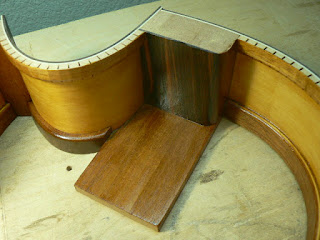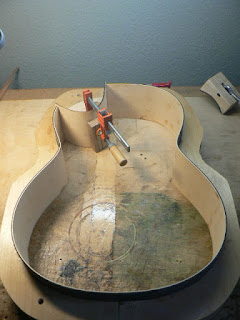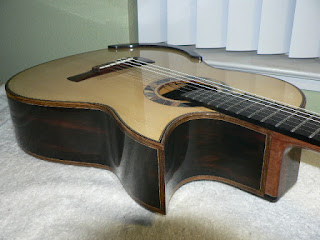I needed a little more works before closing box. The top needed to install two horizontal braces. Lower horizontal brace is for preventing the drumming noise. Without this horizontal bar, a guitar makes drum like noise when you touch strings. Upper horizontal brace is for spreading neck pressure from strings pull into sides. Therefore, this brace has no cross section shaping for weight reduction. This brace needs strongest possible structure.
I also installed three anchor post inserts for an arm-rest. Those are made by Maple.
For the back lattice, I installed patches for cross joints for improving structural stability without significant weight increase. Those patches are made by Maple. After glue the back, I will spray couple of coats of nitro cellulose lacquers. Also, I will apply couple of Shellac coats over the top before glue the top.
Kohei Fujii Guitars

Sunday, December 20, 2015
Sunday, December 13, 2015
Top and Back Lattice Bracing
I completed the top and back lattice bracing work. Top has an Epoxy and graphite laminate structure. This makes super responsible and very powerful sound. Top was thinned to 1.3mm at the thinnest portion. Lattice is made by Adirondack red spruce. The top requires two more horizontal bracing install. Those are conventional spruce bracing.
I also re-shaped the back bracing for much lighter weight. I will install an Epoxy graphite re-enforcement for the cross section of the back bracing.
Next week, I might be able to close the box.
I also re-shaped the back bracing for much lighter weight. I will install an Epoxy graphite re-enforcement for the cross section of the back bracing.
Next week, I might be able to close the box.
Sunday, December 6, 2015
Back lattice brace and Rosetta re-work
I completed back lattice bracing install. Spanish ceder is used for the lattice bracing. You may see that the back has very nice R=12' radius. I have been using the lattice bracing for my offset sound hole Jazz nylon model for a contemporary design taste.
I did a re-work for the Rosetta. I installed an African black wood based Rosetta for this project couple of weeks ago. I was not completely happy with the result for the simple African black wood Rosetta. I will use a Yellow staining for the top. I wanted have a crispy color contrast that works well with the Yellow stain. So, I removed the previous Rosetta, and then re-installed a different design. This time, I installed Black-white-black trim. Inner black border has a 0.3mm thickness. White is a 0.6mm maple. Outer black is a 2mm thickness black died Maple. White and black combination made a very nice and crispy color contrast. I am very happy with the quality for the completed Rosetta.
I did a re-work for the Rosetta. I installed an African black wood based Rosetta for this project couple of weeks ago. I was not completely happy with the result for the simple African black wood Rosetta. I will use a Yellow staining for the top. I wanted have a crispy color contrast that works well with the Yellow stain. So, I removed the previous Rosetta, and then re-installed a different design. This time, I installed Black-white-black trim. Inner black border has a 0.3mm thickness. White is a 0.6mm maple. Outer black is a 2mm thickness black died Maple. White and black combination made a very nice and crispy color contrast. I am very happy with the quality for the completed Rosetta.
Sunday, November 29, 2015
Side assembly complete
I completed side assembly. I have been using solid linings for the top side. Solid lining has three layer laminate configuration using Spanish ceder-Yellow ceder-Spanish ceder combination. For the cut-a-way portion, I made a one piece lining using Mahogany. All solid linings at the top side are able to hold the top very well. Solid lining makes much crispier tonal character, because the solid linings are able to hold the sound board much stronger than conventional kerfed linings. Stronger top support helps to generate stronger over tones. For the back side, I have been using conventional kerfed linings to minimize the guitar weight. Back side does not need strong support for the back board, because the back board is not actively contribute to the tonal character difference. After complete the side assembly, I applied three layers of Shellac with 400-grit sanding. I seal inside of the body completely for better moisture stability. Also, very clean surfaces contribute sound quality improvement. Therefore, I removed all of irregularities inside the body as much as possible.
Sunday, November 15, 2015
Side material cut and block making
Side material laminate was completed last week. I cut side material precisely for fitting the mold. This process requires very detailed and precise cutting and adjustment to get perfect fit to inside the mold. I also completed neck and bottom block making. Tail block has a laminate configuration using different grain direction. Spanish ceder has horizontal grain and Rosewood veneer has vertical grain. This combination makes a lightest and strongest block. Neck block also will be added a vertical grained rose wood veneer for the reinforcement. Next week, I will assemble all blocked inside sides.
Sunday, November 8, 2015
Side bending and laminate
Side bend and laminate works have been done this week. Laminate is for Brazilian RW and Yellow ceder. Brazilian RW was sanded to 1.7mm, and Yellow ceder was sanded to 1.2mm. Those sanding processes are including 220-grit final sanding. Both surfaces are clean and smooth for the good Epoxy gluing quality for the laminate. I have been using the laminated sides for material stability and hard and rigid side structure. Brazilian RW quite often have a clacking issue due to the old growth material. So, the laminate side must be used for the Brazilian RW for me. I also finished the bending and lamination for the cut-a-way portion.
Sunday, November 1, 2015
Brazilian Nylon
In my new work shop, I have been working quite effectively for the new Brazilian Nylon model built. I installed White-Black-White inlay in the back. I do not use a sandwich style back inlay that install a center strip when make a book matched back. Sandwiched back is not stable for me. I always make a channel for the center strip inlay install. This process requires extra time. However, this makes a much stable back. I also installed a center patch for the back. Patch material is Mahogany. As usual, I have been using the vacuum clumping technique. On the top, an offset sound hole was made. I also installed an African black-wood sound hole trim. Next week, I will make back and top lattice bracing.
Sunday, October 25, 2015
New built start
A new nylon model built started. This is a custom order using the best materials. Top is a premium grade European spruce and back and sides are premium grade Brazilian rose wood. This guitar will be a special one for my customer.
Back material is a premium grade Brazilian RW. Unfortunately, size is very small and barely enough to cut a back for classical model. However, this back is not large enough for my back making process. Actuary, the back making needs an extra half inch for gluing and assembly work. So, I added two tiny pieces to make the back material large enough for this guitar making. You may see the first photo that has two small triangle pieces for filling empty spaces. This portion will not be used for the completed guitar. However, I need this portion during this guitar making process. Now the book match jointed back is large enough for the back. You may see the back has pretty good straight grains. This level of perfectly quarter-swan Brazilian RW back is very hard to obtain.
The book match joint for the top is also completed. This top has almost perfect cross section of grain. Year rings are quite tight. Tap tone of this material is amazing.
Back material is a premium grade Brazilian RW. Unfortunately, size is very small and barely enough to cut a back for classical model. However, this back is not large enough for my back making process. Actuary, the back making needs an extra half inch for gluing and assembly work. So, I added two tiny pieces to make the back material large enough for this guitar making. You may see the first photo that has two small triangle pieces for filling empty spaces. This portion will not be used for the completed guitar. However, I need this portion during this guitar making process. Now the book match jointed back is large enough for the back. You may see the back has pretty good straight grains. This level of perfectly quarter-swan Brazilian RW back is very hard to obtain.
The book match joint for the top is also completed. This top has almost perfect cross section of grain. Year rings are quite tight. Tap tone of this material is amazing.
Sunday, October 11, 2015
A Little bit modification for the Jazz Negra model.
Jazz Negra was sold on the La Guitarra. Before ship this guitar, I need to modify a little bit for my client. This guitar needs to remove Avalon side dots. I removed them and filled with African black wood dowels. Then, the guitar was partially finished with the Emtech EM6000 Acrylic finish. Next week, I polish the finish and install an electrical pick-up system (L.R. Baggs LB-12 with dual source system), and then ship the guitar to San Diego.
Sunday, September 27, 2015
La Guitarra
I returned from La Guitarra California guitar festival. There are wonderful guitars in the guitar vendor exhibition. Also, there are wonderful guitar makers. I am extremely happy to see nice people in this guitar makers' community. Thank you so much for being with my friend for Michael Elwell, Tim McCoy, Gil Carnal, Bruce Thompson, and Glen Perry. Those friends were made my exhibition work so comfortable. Thank you for all visitors who stop by my booth to try-out my guitars.
Sunday, September 13, 2015
All completed
Myrtle model was completed this week. Now, both Negra and Myrtle models are ready for the guitar show. Myrtle model showed amazing fiddle back flames including the Maple neck. This is a truly gorgeous guitar. Myrtle model employed a 24.9" short scale for the super high tension strings. Short scale made this guitar for a super easy playing one. This is a Jazz guitarist's choice. I put a GHS high tension strings set (Manuriel Anderson Signature series strings) MA2309. This guitar showed very nicely balanced tone. Bass is a bit too strong; however, I am quite sure that in one year of playing, the strong bass will calm down with more over tones. Last image shows three guitars inducing my personal nylon-strings guitar. I completed this one in August 2014. This guitar has very good tonal balance with a lot of over tones now. First time I tested this guitar, I thought that I made mistake for too much strong buss. After, one year of playing, this guitar has excellent tonal balance.
For the center hole model (Negra). This guitar has a traditional classical concert guitar tone. Not too strong buss. Well balanced tonal distribution from treble to buss. A lot of over tones are already exist. This guitar is much heavier than the Myrtle model due to the heavier material (Malaysian Black wood) and a steel truss rod installed. This guitar has much longer tonal sustain time.
Monday, September 7, 2015
Negra Model Completed
Negra model is completed. Although the bridge bone is a temporary one. I just installed something available in my shop, and I just put strings as a test. So, the action is way too low at this moment. I just wanted to check the fingerboard surface and fret-wire flatness. It seems pretty good. This guitar already showed an amazing potential. Sound of this guitar is like a grand piano. Bass the strong and deep and treble is crystal clear. I was so stroked from the initial test. I will make a real bone saddle and complete the final setting this week.
Subscribe to:
Comments (Atom)


















































